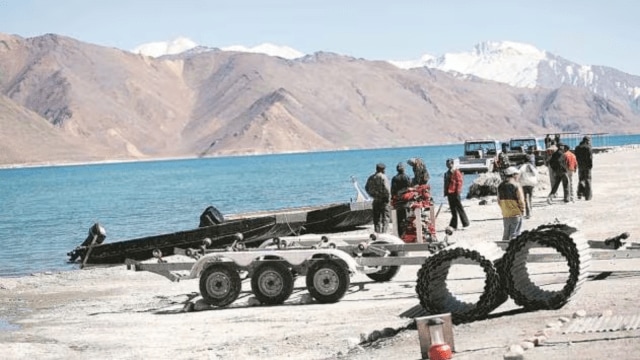India, China agree to maintain stability along LAC, continue existing border mechanisms
At 23rd round of Corps Commander talks, both sides note peace has been maintained. However, even after disengagement along LAC full de-escalation in eastern Ladakh remains pending.
 While the thousands of Indian troops deployed in eastern Ladakh continued to maintain high vigilance, both sides have been working on reducing the trust deficit with Chinese troops on the ground by implementing additional confidence-building measures (Express Archives)
While the thousands of Indian troops deployed in eastern Ladakh continued to maintain high vigilance, both sides have been working on reducing the trust deficit with Chinese troops on the ground by implementing additional confidence-building measures (Express Archives)In the first high-level military talks since India and China completed the disengagement of troops from key friction points along the Line of Actual Control (LAC) in eastern Ladakh last October, the two sides agreed to continue to use “existing mechanisms to resolve any ground issues along the border to maintain stability”.
The 23rd round of Corps Commander-level talks was held at the Chushul-Moldo border meeting point on October 25, the Ministry of External Affairs (MEA) said on Wednesday.
The meeting — the first high-level engagement since the Special Representatives’ talks on August 19 — came a year after both sides disengaged from the friction points in October last year, following the 22nd round of military talks.
Following the agreement between the two sides last October, both sides have been carrying out coordinated patrols to avoid clashes between the troops on the ground.
In a statement, the MEA said the discussions were held in a friendly and cordial atmosphere and that both sides “shared the view that peace and tranquility has been maintained” in the border areas.
Sources said the meeting was aimed at strengthening coordination and avoiding any incident, while continuing with various confidence building measures in place. Battalion and brigade-level commander meetings will be held as and when required.
(PTI adds: A Chinese readout on the Corps Commander talks said the two sides engaged in active and in-depth communication on the management of the western section of the China-India border. The two sides decided to maintain communication and dialogue as decided by Prime Minister Narendra Modi and Chinese President Xi Jinping, it said.
“They agreed to continue communication and dialogue through military and diplomatic channels under the guidance of the important consensus reached by the leaders of the two countries, and jointly safeguard peace and tranquillity in the China-India border areas,” the readout by the Chinese defence ministry said.)
The latest round of military talks comes amid efforts from both sides to consolidate relative calm on the ground, following the heightened deployment of troops since the military standoff in eastern Ladakh began in 2020.
Even after the disengagement process, a full de-escalation is yet to take place. While sources say that China has withdrawn some troops, an estimated 50,000-60,000 troops are still stationed on either side of the LAC in the region.
Discussions at the diplomatic and military levels have been underway to prioritise existing border areas that can be taken up first for the resolution of issues.
After over four years of the military standoff, the breakthrough came in October last year, when India and China reached an agreement on patrolling arrangements in the Depsang Plains and Demchok, the two friction points along the LAC. The announcement of the agreement set the stage for a meeting between Modi and Xi on the sidelines of the BRICS Summit in Kazan, Russia, on October 23, 2024, when their talks resulted in disengagement of troops from the friction points.
The two leaders again met on the sidelines of the Shanghai Cooperation Organisation (SCO) Summit in Tianjin on August 31 this year — this was Modi’s first visit to China in seven years. Underlining the move to repair bilateral ties, they emphasised that the two countries were “partners, not rivals”, marking an important shift as both sides work towards gradual normalisation.
“After the disengagement at the border, an atmosphere of peace and stability is now in place,” Modi had said. The Chinese Foreign Ministry had quoted Xi as saying that the Kazan meeting “marked the restart of China-India relations, with exchanges and cooperation between the two countries making continuous progress”.
“Our Special Representatives have also reached an agreement on border management,” Modi had said, referring to the two meetings between National Security Advisor Ajit Doval and Chinese Foreign Minister and Politburo member Wang Yi in December last year and August this year.
In a series of steps towards stabilisation of ties, the two sides have announced the resumption of the Kailash Mansarovar Yatra and direct flights.
On the ground, even as thousands of troops continue to maintain high vigilance along the LAC, both sides have been working on reducing the trust deficit by implementing additional confidence-building measures.
For India, this also means placing a greater reliance on the technical surveillance infrastructure that has been established over the last five years, which is being further upgraded and strengthened, with the long-term aim of reducing additional patrolling efforts.
The Indian Express reported last month that India has established a comprehensive surveillance network to extensively monitor the LAC and surrounding areas round the clock.
The Army will also be carrying out a redeployment of its troops deployed in higher reaches which will be affected by the approaching winter in eastern Ladakh.







